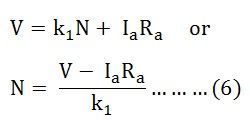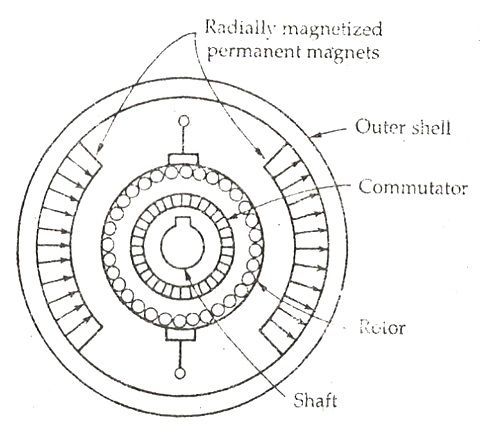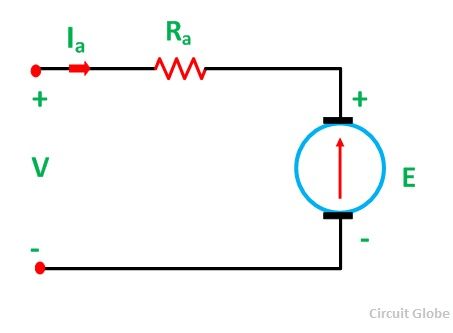A DC Motor whose poles are made of Permanent Magnets is known as Permanent Magnet DC (PMDC) Motor. The magnets are radially magnetized and are mounted on the inner periphery of the cylindrical steel stator. The stator of the motor serves as a return path for the magnetic flux. The rotor has a DC armature, with commutator segments and brushes.
The cross-sectional view of the 2 pole PMDC motor is shown in the figure below.
The Permanent Magnet DC motor generally operates on 6 V, 12 V or 24 Volts DC supply obtained from the batteries or rectifiers. The interaction between the axial current carrying rotor conductors and the magnetic flux produced by the permanent magnet results in the generation of the torque.
The circuit diagram of the PMDC is shown below.
In conventional DC motor, the generated or back EMF is given by the equation shown below.![]()
The electromagnetic torque is given as
In Permanent Magnet DC motor, the value of flux ϕ is constant. Therefore, the above equation (1) and (2) becomes
Considering the above circuit diagram the following equations are expressed.![]()
Putting the value of E from the equation (3) in equation (5) we get
Where k1 = k ϕ and is known as speed-voltage constant or torque constant. Its value depends upon the number of field poles and armature conductors.
The speed control of the PMDC motor cannot be controlled by using flux control method as the flux remains constant in this type of motor. Both speed and torque can be controlled by armature voltage control, armature rheostat control, and chopper control methods. These motors are used where the motor speed below the base speed is required as they cannot be operated above the base speed.
Types of Permanent Magnet Materials
There are three types of Permanent Magnet Materials used in PMDC Motor. The detailed information is given below.
Alnicos
Alnicos has a low coercive magnetizing intensity and high residual flux density. Hence, it is used where low current and high voltage is required.
Ferrites
They are used in cost sensitive applications such as Air conditioners, compressors, and refrigerators.
Rare earths
Rare earth magnets are made of Samarium cobalt, neodymium-iron-boron. They have a high residual flux and high coercive magnetizing intensity. The rare earth magnets are exempted from demagnetizing problems due to armature reaction. It is an expensive material.
The Neodymium iron boron is cheaper as compared to Samarium cobalt. But it can withstand higher temperature. Rare earth magnets are used for size-sensitive applications. They are used in automobiles, servo industrial drives and in large industrial motors.
Applications of the Permanent Magnet DC Motor
The PMDC motors are used in various applications ranging from fractions to several horsepower. They are developed up to about 200 kW for use in various industries. The following applications are given below.
- PMDC motors are mainly used in automobiles to operate windshield wipers and washers, to raise the lower windows, to drive blowers for heaters and air conditioners etc.
- They are also used in computer drives.
- These types of motors are also used in toy industries.
- PMDC motors are used in electric toothbrushes, portable vacuum cleaners, food mixers.
- Used in a portable electric tool such as drilling machines, hedge trimmers etc.
Advantages of the Permanent Magnet DC Motor
Following are the advantages of the PMDC Motor.
- They are smaller in size.
- For smaller rating Permanent Magnet reduces the manufacturing cost and thus PMDC motor are cheaper.
- As these motors do not require field windings, they do not have field circuit copper losses. This increases their efficiency.
Disadvantages of the Permanent Magnet DC Motor
The disadvantages of the PMDC motor are given below.
- Permanent magnets cannot produce a high flux density as that as an externally supplied shunt field does. Therefore, a PMDC motor has a lower induced torque per ampere turns of armature current then a shunt motor of the same rating.
- There is a risk of demagnetization of the poles which may be caused by large armature currents. Demagnetization can also occur due to excessive heating and also when the motor is overloaded for a long period of time.
- The magnetic field of PMDC motor is present at all time, even when the motor is not being used.
- Extra ampere turns cannot be added to reduce the armature reaction.



Your article is very helpful for me.
Thank you for producing such cleat text and drawings on all these various motor types.
What would you expect the efficiency loss to be for a 36volt, 1000W permanent magnet motor, as applied to a golf cart?
Alternatively what would you expect of the endurance of a cart of following specs?
Motor 36v. 1000W
Batteries 12v, each 20 AH Arranged series parallel 3 x 2?
thanks
THANK YOU, THIS WAS VERY HELPFUL
good information, very usefull